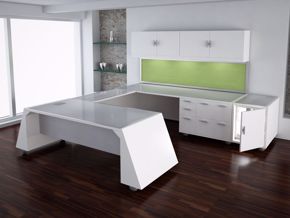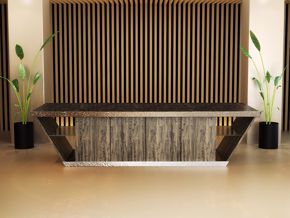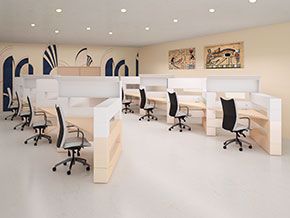If you haven’t noticed the impact things have on the people around you, you are not alone. Rarely does the average person think of changing their surroundings as a way of affecting human behavior. When we don’t get the response we want from others, we look to change them, not their environment. By focusing strictly on the human side of things, we totally miss the subtle yet powerful impact of objects on our unconscious thinking—the size or scale of a room and the furniture in it, a wall color, the type and comfort level of a chair, and so much more.
In the words of Fred Steele, a sociotechnical theorist, most of us are “environmentally incompetent,” like fish who know nothing but water. In much the same way, our physical environment remains silent. Hidden in plain sight, it doesn’t speak out. There is never any friction, so we don’t realize its presence. Because of this, we miss the impact of things around us on the behavior of others. Stated in reverse, we don’t use things to our advantage to drive change when transforming our workplace.
Things—a great resource tool
You don’t need to fight with things. No discussions, no cajoling…nothing! They just sit there, unassuming and creating silent impact.
George Keeling, a social scientist, asserted that a thing—like a broken window left in disrepair—can give the impression that no one cares, no one’s in charge, and it’s okay to break another and still another. If allowed to continue on this path, the whole neighborhood would be affected.
Keeling established this theory as a follow-up to an experiment organized at Stanford by psychologist Philip Zimbardo. In this experiment, Zimbardo parked an apparently disabled and abandoned car in a low-income area of the Bronx. Within one day, everything in the car had been stolen. A few days later, vandals had smashed the car’s windows and ripped out the upholstery. Thereafter, other people Zimbardo labeled as mostly well dressed, “well-groomed” Caucasians became party to the wreckage. Zimbardo deduced, by way of this experiment, that in high-crime areas like the Bronx, where neglected property is ordinary, vandalism and theft happen much faster when the community ignores the issues. However, parallel behavior can take place in any neighborhood when people have a general disregard for care and concern.
Taken in the opposite direction, in a neighborhood where the streets are repaired or cobblestoned, streetlights are replaced or repaired, buildings are painted, and new construction is underway, rents consistently go up and new people move in.
Things can tell people what to do silently
A painted line on a floor tells people where to go, a roped off area tells people at the bank where the line forms, and a colored trash can tell people where to put recyclable materials. A reception desk blocking or near an entranceway tells people where to stop.
Strategic use of objects people relate to in a meaningful way can make a workplace function more efficiently without a lot of words. Controlled switches for lights and AC units, for example, help people remember to conserve energy. Placement of relevant storage instruments (appropriate to type size and shape of what’s being stored) at each workstation help people become more organized and find things faster. Proximity can be used to encourage desired behavior, and distancing can be implemented to discourage unwanted action. Allow people who need support easy access to people who can help by virtue of proper seating arrangements or virtual access.
Things tell people what to think
White tablecloths in a restaurant, fashionable lighting, crystal glassware and fine artwork tells people it’s a fine quality establishment. A person wearing a white lab coat in a hospital tells people who to trust and where to seek information. A quality reception desk in business lobby environment tells people it’s an upscale, professional business. A trendy modern desk can give the impression of a forward-thinking company, whereas a traditional one will relay that you have old-fashioned values and are rule conscious.
Use things in the workplace to guide the direction of thought. Objects in the office are silent communicators. Wall colors and floor patterns have a language of their own. Office furniture is a good silent communicator, as well. All of these can impart the attitude and branding of the company. Use them to your advantage.
Unconscious choices matter. Make them obvious.
If environmental influences are something that remain invisible to most of us, why not make desired behavior more obvious and easier to attain? First, become more aware of which behaviors are being enacted, then make the necessary changes to the environment to direct your preferred changes. If it is action changes you seek, create the tools, furniture, compartments, signs, ropes, and/or distances you need to make the outcome more comprehensive.
If it is mental influence you seek to create, decide upon the outcome, then create the perfect surroundings to match that mental picture.
Learn from the pros
When it comes to influence strategy/implementation and streamlined design in their environment, Las Vegas casinos use every tool in the shed: desirable and influential people, entertainment, furniture, and appointments all dictate pricing.
The idea is to use people and things to gain psychological influence. In this way, they encourage their customers to spend more money.
There are no clocks anywhere in a casino. This is a strategy to keep customers spending money.
There is never a window. This is a way to influence customers to not be mindful of time.
The noise from machines and the flashing lights attracts customers to play because they see and hear people winning. Conversely, machines are quiet when losing.
There is almost never a right-angle wall leading to the door, which is a visual deterrent to keep people in place.
Seating is designed with ergonomics in mind to keep customers comfortable as they play. Placement of slot machines in nooks simulates intimacy for greater comfort and ease. ATM machines are readily available so that people never run out of money.
I could go on forever detailing the masterful strategies used by Las Vegas casinos, but the purpose of this article in not to describe Las Vegas. That’s only here to demonstrate how object design and placement silently work to influence our thinking.
Fred Steele estimated that we make over 280 unconscious choices daily. What better milieu than the workplace to guide people in the direction that can best help them, and their companies succeed?
At 90 Degree Office Concepts, we work to help our clients represent themselves in the most appealing ways. The goal is to help create an environment that speaks to your company’s strong points, establishing a functional, psychological, and meaningful environment in which to grow.










